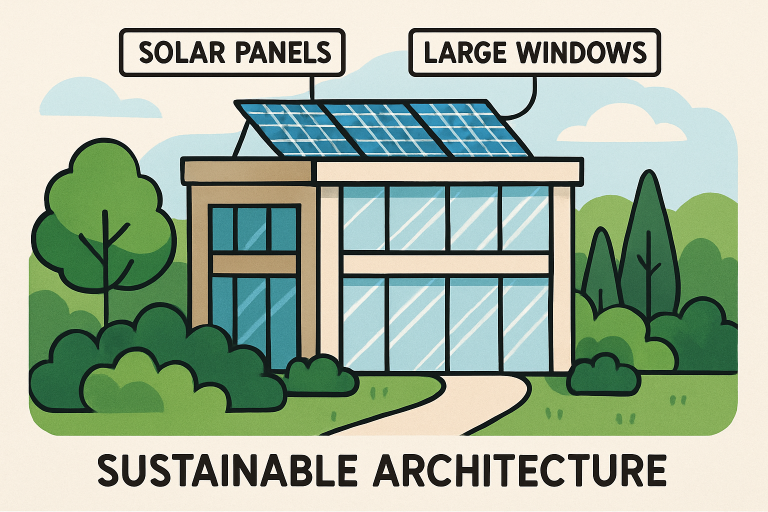Table of Contents
- What Is Green Architecture?
- Core Principles of Sustainable Design
- Environmental Benefits
- Role of Architects in Sustainable Living
- Innovative Materials and Techniques
- Overcoming Challenges in Green Architecture
- Future of Green Architecture
What Is Green Architecture?
Green architecture encompasses the philosophy and processes of designing and constructing buildings that lessen environmental impacts and foster sustainable living. Rather than a single approach or technology, it involves a combination of energy-efficient features, responsible material sourcing, intelligent site planning, and holistic design practices that prioritize human health and planetary well-being. Architects who embrace this vision — such as architects Gladwyne, PA — are not only responding to global environmental concerns, but are also setting new standards for how we live, work, and interact with our surroundings.
With urban landscapes expanding and climate change urgent, green architecture offers a vital chance to build smarter. These practices reduce a building’s carbon footprint, conserve resources, and promote occupant health and productivity. Architects and designers are key, as their early decisions shape the sustainability and resilience of our environment.
Core Principles of Sustainable Design
- Prioritizing energy efficiency through strategies like passive solar design, high-performance insulation, and renewable energy integration.
- Reducing water consumption with efficient plumbing fixtures, rainwater harvesting, and smart irrigation.
- Choosing materials that are local, renewable, recycled, or low in embodied carbon whenever feasible.
- Enhancing access to daylight and natural ventilation to decrease reliance on artificial lighting and mechanical systems.
At its core, sustainable design is about making wise choices at every step. Whether optimizing window orientation to harvest solar energy or selecting non-toxic finishes to improve indoor air quality, these principles are foundational to green architecture worldwide.
Environmental Benefits
The advantages of sustainable architecture reverberate throughout ecosystems and urban centers alike. According to the U.S. Environmental Protection Agency (EPA), green buildings reduce energy consumption, save water, and lower greenhouse gas emissions substantially compared to conventional construction. In addition to climate benefits, such buildings can reduce local air and water pollution, minimize construction waste, and promote urban biodiversity by incorporating green roofs, gardens, and permeable surfaces into their design.
Increasingly, scientific research — such as findings published by the New York Times — shows that even modest sustainable modifications can yield significant positive impacts for city air quality, heat-island reduction, and resilience against extreme weather events.

Role of Architects in Sustainable Living
Architects are key changemakers in sustainable construction, influencing design, materials, and site management. Beyond technical skills, they educate clients on energy, costs, and biophilic features that boost well-being and cut expenses. Collaborating with clients, engineers, and communities, they promote updated codes, new technologies, and public awareness. Since the built environment causes about 40% of global emissions, their proactive role is vital for lasting change.
Innovative Materials and Techniques
Innovation thrives in green building, with architects using new and traditional methods. Bamboo and cross-laminated timber (CLT) offer low-carbon, durable alternatives to concrete and steel. Reclaimed wood, recycled glass, and low-VOC paints reduce environmental impact. Modern projects feature solar facades, smart glass, green roofs, and rainwater harvesting. Old techniques like passive heating are being reimagined with advanced tools. As ArchDaily notes, these innovations are making green architecture more practical and affordable.
Overcoming Challenges in Green Architecture
Despite benefits, advancing green architecture faces barriers like budget constraints, zoning laws, and lack of awareness. However, government incentives, new building codes, and demand for healthy, future-oriented spaces are improving prospects. Education helps show that green buildings often lower long-term costs through reduced energy, water, and maintenance, as per the U.S. Green Building Council. Open communication and creative design are key to overcoming hurdles. As more architects aim for certifications like LEED, WELL, or Living Building Challenge, these standards also promote market change.
Future of Green Architecture
As sustainability becomes central in architecture, the future promises drastic shifts, with biophilic design, modular construction, and net-positive buildings on the rise. Urban planners and architects will use digital modeling, AI, and renewable energy to craft resilient, adaptable spaces for the 21st century. The shift to green architecture encourages all—architects, clients, and communities—to view the built environment as a force for positive change, making sustainable living more achievable.



